Regional employment patterns in Scotland: statistics from the Annual Population Survey 2017
Summary publication of results from the Annual Population Survey 2017, presenting analysis on the labour market, education and training.
This document is part of a collection
Section 1: Employment
1.1 Overview
In 2017, 2,729,300 people aged 16 years and over were economically active in Scotland. Scotland’s economic activity rate (16-64) in 2017 was 77.5 per cent, lower than the UK rate of 78.2 per cent.
Who is classed as economically active?
Economically active individuals are those who are in
employment or have been actively seeking work and are available to
start work (an International Labour Organisation
definition).
Of the population aged 16-64 years in Scotland in 2017, 74.3 per cent were in employment, 3.2 per cent were ILO unemployed and 22.5 per cent were economically inactive.
Figure 1: Scotland population aged 16 to 64 years by economic category, 2017
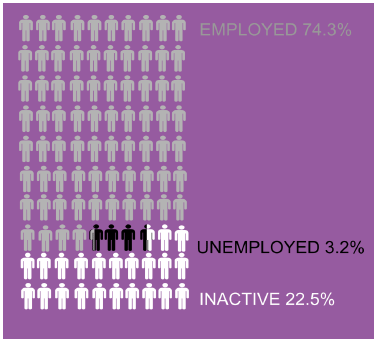
Note: The ILO unemployment rate was 4.1 per cent (expressed as a percentage of economically active 16 years and above).
In 2017, 2,618,100 people (aged 16 years and over) were in employment in Scotland, the highest level on record.
The employment rate (16-64) was also at the highest record at 74.3 per cent, although is below the UK rate of 74.7 per cent.
Who is classed as in employment?
If a person is over 16 years old and has done at least one
hour of paid work in the week prior to their Labour Force Survey (
LFS) interview or
have a job that they are temporarily away from.
Chart 1: Employment rate (16-64): Scotland and UK, 2004-2017
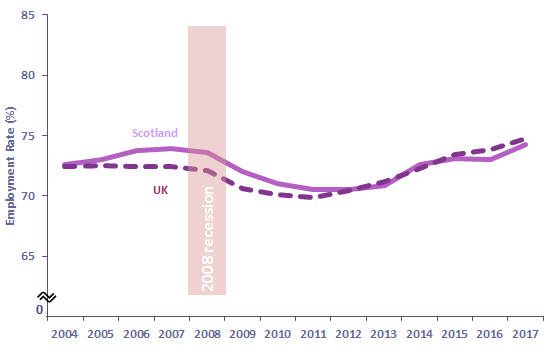
1.2 Cohesion
Cohesion
There is considerable variation in the employment rates for those aged 16-64 years across Scotland’s local authorities.
The gap in the employment rate of the top 3 performing and bottom 3 performing local authorities in Scotland increased by 1.1 percentage points over the year to 16.5 percentage points in 2017.
The gap is slightly higher compared with 2007 when the gap was 16.1 percentage points. However, this has reduced considerably from 2012 when the gap reached its peak at 19.9 percentage points.
Chart 2: Employment rate (16-64): for top 3 and bottom 3 local authorities
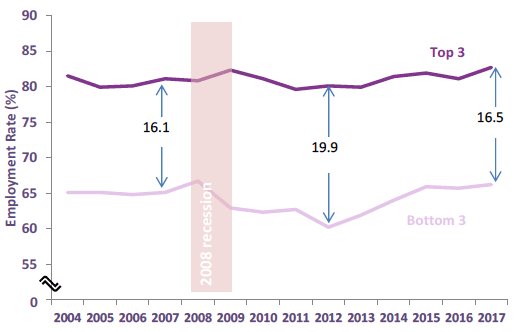
Local authorities
In 2017, the highest employment rates were seen in; Orkney Islands (88.3 per cent), Shetland Islands (82.7 per cent), Aberdeenshire (82.3 per cent) and Na h-Eileanan Siar (81.1 per cent).
The lowest rates were seen in: Dundee City (65.4 per cent), Glasgow City (66.0 per cent), North Ayrshire (68.1 per cent) and East Ayrshire (71.0 per cent).
In the last 2 years
In the last year, the employment rate increased by 1.3 percentage points from 73.0 per cent to 74.3 per cent. This compares with the UK which increased by 0.9 percentage points from 73.8 per cent to 74.7 per cent.
The employment rate in Scotland recovered again between 2016 and 2017 after decreasing slightly the year before. Decreasing by 0.1 percentage points from 73.1 per cent in 2015 to 73.0 per cent in 2016. The largest decrease in 2015 to 2016 for an individual local authority was in Aberdeen City with the employment rate falling from 76.7 per cent* in 2015 to 70.3 per cent in 2016.
From 2016 to 2017, the employment rate for Scotland increased by 1.3 percentage points to 74.3 per cent. The employment rate in Aberdeen City increased from 70.3 per cent to 76.1 per cent. This was the largest increase in employment rate for a single local authority (a statistically significant change).
Since 2007, Scotland’s employment rate has increased by 0.4 percentage points, compared with the UK which increased by 2.3 percentage points.
1.3 Local authorities
Figure 2: Employment rate 2017 (16-64 year olds) per cent
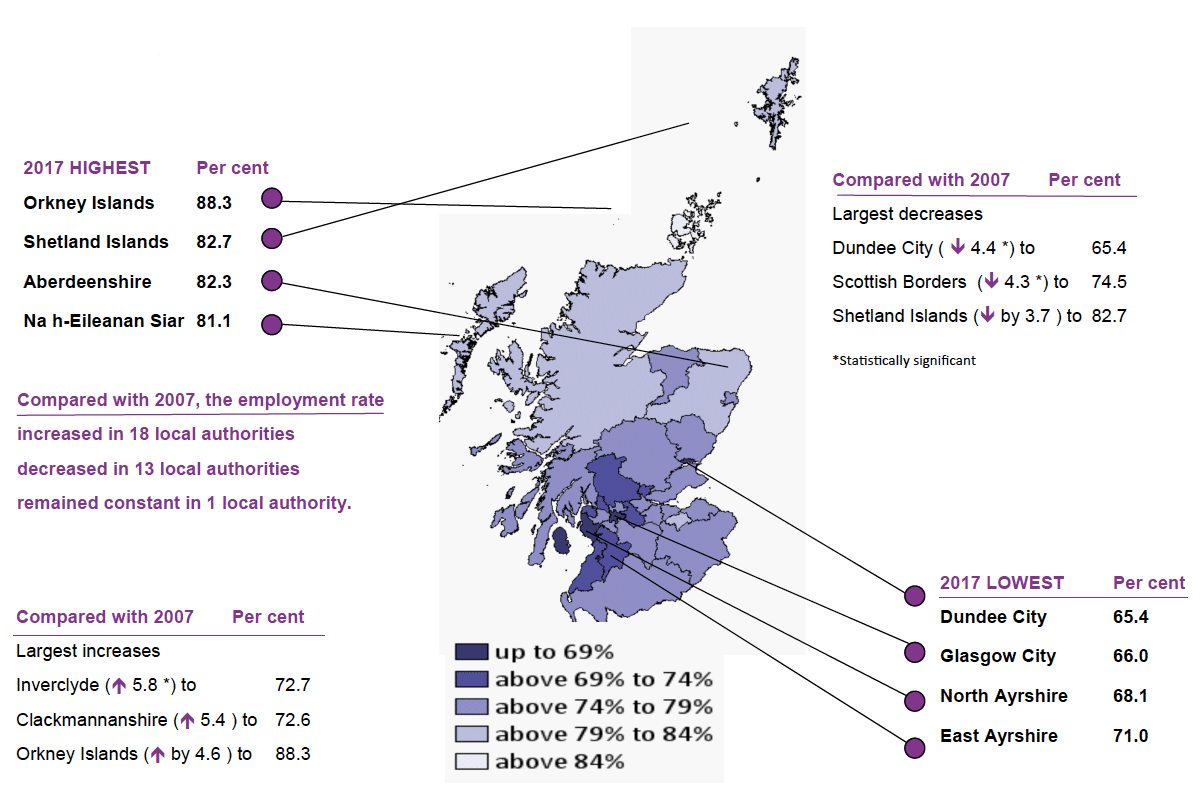
1.4 Gender
The gender employment gap is the difference between the employment rate for men and women. The gap has decreased from 10.6 percentage points in 2007 to 6.9 percentage points in 2017.
Since 2011, the employment level and rate have increased at a steeper rate for women compared with men in Scotland.
1,272,300 women were in employment in 2017, 72,800 more compared with 2007. The employment rate for women has increased by 2.2 percentage points from 68.7 per cent in 2007 to 70.9 per cent in 2017.
The employment rate for men was 77.8 per cent, lower than 79.3 per cent in 2007.
Chart 3: Employment rate (16-64) by gender
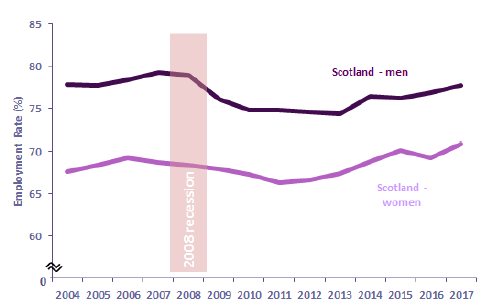
Chart 4: Employment rate (16-64) gap: Scotland and the UK
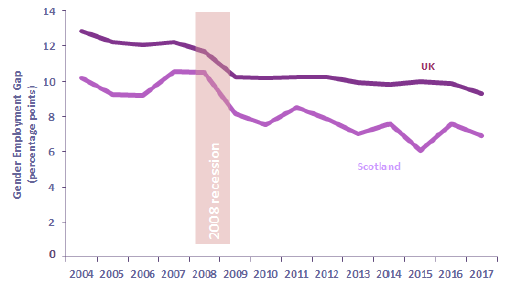
Chart 5: Employment level (16+) by gender
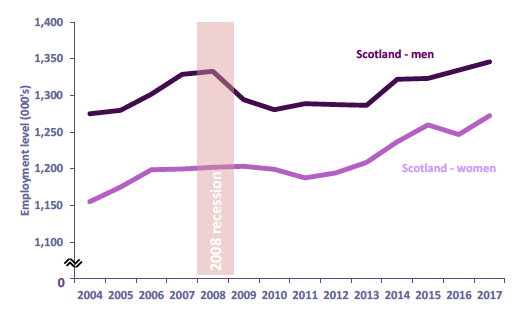
Local authorities
Since 2007, the employment rate for women has increased in 23 of the 32 local authorities. Whereas for men the employment rate had increased in only 11 of the 32 local authorities.
In 2017 the highest women’s employment rates were in; Orkney Islands (85.8%), Shetland Islands (83.8%), Highland (80.0%) and Na h-Eileanan Siar (78.1%).
Whereas for men the highest employment rates were in Orkney Islands (90.7%), Aberdeenshire (88.6%), Na h-Eileanan Siar (83.9%) and West Lothian (82.3%).
Local authorities where the employment rate increased between 2007 and 2017 for both men and women were: Aberdeenshire, Clackmannanshire, Dumfries and Galloway, Fife, Inverclyde, Na h-Eileanan Siar, Orkney Islands, Renfrewshire and West Lothian.
Local authorities where the employment rate increased between 2007 and 2017 for men only were: Argyll and Bute and East Ayrshire.
Local authorities where the employment rate increased between 2007 and 2017 for women only were: Angus, East Lothian, East Renfrewshire, Edinburgh, Glasgow City, Highland, Midlothian, North Ayrshire, North Lanarkshire, Perth and Kinross, Shetland Islands, South Ayrshire, Stirling and West Dunbartonshire.
Local authorities where the employment rate decreased between 2007 and 2017 for both males and females were: Aberdeen City, Dundee City, East Dunbartonshire, Falkirk, Moray, Scottish Borders and South Lanarkshire.
Chart 6: Women’s employment rate (16-64) by local authority, 2007 to 2017
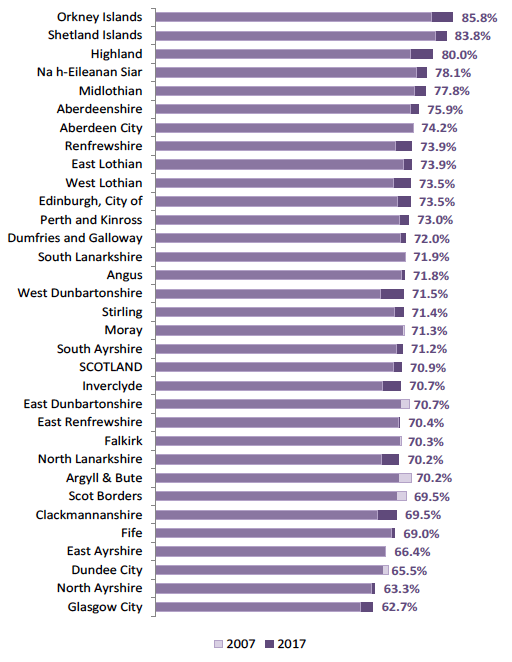
Note: Employment rate labels displayed for 2017
1.5 Age
Chart 7: Men’s employment rate (16-64) by local authority, 2007 to 2017
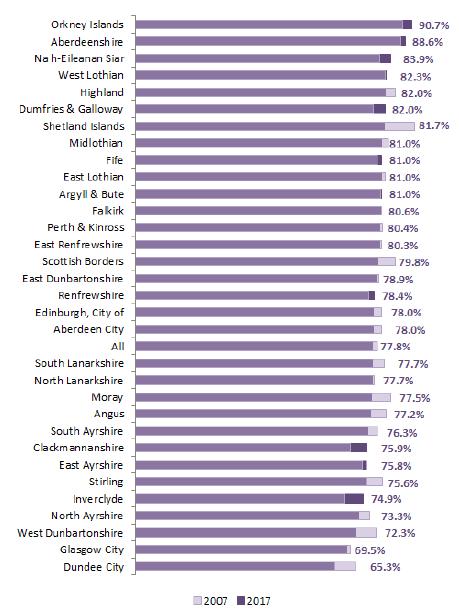
Note: Employment rate labels displayed for 2017
The employment rate for young people (aged 16-24 years) has increased in the last year with 59.4 per cent of those aged 16-24 years in employment.
Employment rates for 25-34 and 35-49 year olds have remained around 80 per cent from 2004 to 2017, indicating a fairly high resilience to economic change.
In 2017, the employment rate for 25-34 year olds was 82.0 per cent while 35-49 year olds had the highest employment rate at 82.2 per cent.
Young workers (16-24) saw the main impact of the recession with their employment rates reducing from 62.6 per cent in 2007 to 52.7 per cent in 2013. Although there was a slight decline to 2016, there has been a steep increase in the last year to 59.4 per cent.
In contrast, employment rates for those aged 50-64 have increased through the recovery remaining fairly constant over the last year (69.6 per cent in 2017).
Chart 8: Employment rate (16-64) by age
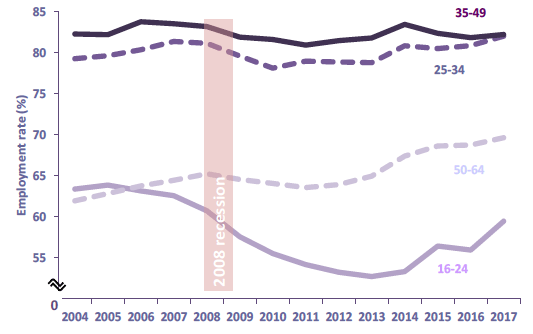
Contact
If you have any enquiries relating to Labour Market Statistics then please contact us at:
Email: LMStats@gov.scot
Telephone: 0131 244 6773
Fax: 0300 244 1060
Post:
Labour Market Statistics
OCEAES: Economic Strategy and Policy
Scottish Government
5th Floor
5 Atlantic Quay
150 Broomielaw
Glasgow
G2 8LU
We welcome any comments on both the format and content of the website, including any problems you may encounter.
You may also contact the Statistician Group Enquiries for general information.
There is a problem
Thanks for your feedback